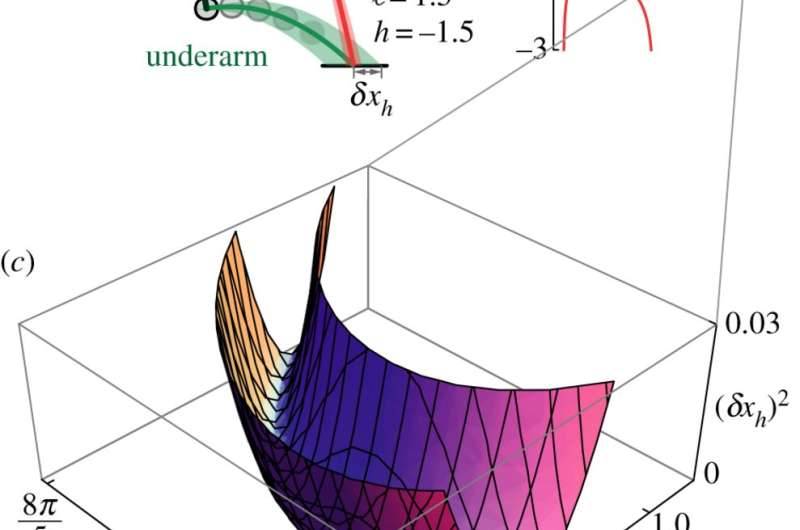April 26, 2017 report
Study identifies optimum human hand-throwing techniques

(Phys.org)—A pair of researchers with Harvard and Yale Universities has conducted a study of optimal human throwing techniques and found which work best under which conditions. In their paper published in the journal Royal Society Open Science, Madhusudhan Venkadesan and Lakshminarayanan Mahadevan describe how they combined physics with observed results to learn which techniques work best in which situations.
Humans have two basic ways of throwing—overhand or underhand. The approach used can impact accuracy, the researchers note, but there are other factors at play, as well. One example is throwing a basketball through a basketball net. During play, the action is fast, and there are other players attempting to steal the ball, so there are few if any attempts at underhand throwing. But, the researchers note, underhand throwing (aka granny style) when attempting to make free throws, can be more effective for players who practice the technique. The advantage, they note, is the way in which the ball approaches the target—when it comes in from just above the rimmed net, the target cross-section is relatively large, which means there is a better chance of the ball making it through the hoop than a ball that comes in at more of an angle. But the player has to have good control—sending the ball too high reduces the advantage, and sending it too low of course, removes all chances of success.
The same science is at play in other throwing activities, they note, whether it is cricket, darts or tossing a waded paper at the waste can. Slower arcs, they found, result in better results. Faster throws cause an object to arrive at the target more quickly, but are generally less accurate. But there are exceptions to the success rule—such as when trying to toss accurately while at the same time attempting to prevent another player from hitting the object, such as in cricket or baseball.
The researchers came to their conclusions by applying physics calculations to real-world throwing data, such as from studies of volunteers throwing paper wads into wastebaskets. They note also that accurate throwing is strictly human—monkeys throw things, they acknowledge, such as feces, but despite reports at zoos, they are very inaccurate.
More information: M. Venkadesan et al. Optimal strategies for throwing accurately, Royal Society Open Science (2017). DOI: 10.1098/rsos.170136
Abstract
The accuracy of throwing in games and sports is governed by how errors in planning and initial conditions are propagated by the dynamics of the projectile. In the simplest setting, the projectile path is typically described by a deterministic parabolic trajectory which has the potential to amplify noisy launch conditions. By analysing how parabolic trajectories propagate errors, we show how to devise optimal strategies for a throwing task demanding accuracy. Our calculations explain observed speed–accuracy trade-offs, preferred throwing style of overarm versus underarm, and strategies for games such as dart throwing, despite having left out most biological complexities. As our criteria for optimal performance depend on the target location, shape and the level of uncertainty in planning, they also naturally suggest an iterative scheme to learn throwing strategies by trial and error.
Journal information: Royal Society Open Science
© 2017 Phys.org


















